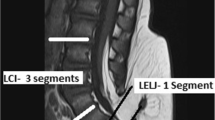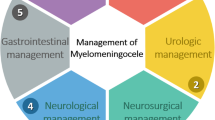Abstract
Objective
An objective clinical assessment tool whose accuracy and reproducibility can be validated is essential for the initial evaluation, selection for surgery and surveillance of children with lipomyelomeningocele (LMMC). The aim of this study was to analyse the large number of such tools presently in use and recommend an alternative that could lead to greater uniformity between different series and greater consistency in the assessment of individual patients.
Methods
A systematic review of the literature between January 1980 and December 2010 was undertaken and details of how the children in each series were assessed and the degree to which age was taken into account recorded.
Results
Thirty-six different assessment tools were used in 40 different publications. None was validated in all aspects. Objective measures were used most in urological assessments but rarely in other domains. Age-specific assessments were used in only 10 % of publications.
Conclusion
This study confirmed that the assessment tools for evaluation of children with LMMC are inconsistent, often vague and poorly validated. This compromises the ability of clinicians who care for them to compare studies across centres for both treated and untreated children. We have sought to highlight those criteria which are relevant, measurable and reproducible and which might be combined into an easily applied assessment.
Similar content being viewed by others
References
Al-Holou WN, Muraszko KM, Garton HJ, Buchman SR, Maher CO (2009) The outcome of tethered cord release in secondary and multiple repeat tethered cord syndrome. J Neurosurg Pediatr 4(1):28–36
Arai H, Sato K, Okuda O, Miyajima M, Hishii M, Nakanishi H, Ishii H (2001) Surgical experience of 120 patients with lumbosacral lipomas. Acta Neurochir (Wien) 143(9):857–864
Atala A, Bauer SB, Dyro FM, Shefner J, Shillito J, Sathi S, Scott RM (1992) Bladder functional changes resulting from lipomyelomeningocele repair. J Urol 148(2 Pt 2):592–594
Bulsara KR, Zomorodi AR, Villavicencio AT, Fuchs H, George TM (2001) Clinical outcome differences for lipomyelomeningoceles, intraspinal lipomas, and lipomas of the filum terminale. Neurosurg Rev 24(4):192–194
Byrne RW, Hayes EA, George TM, McLone DG (1995) Operative resection of 100 spinal lipomas in infants less than 1 year of age. Pediatr Neurosurg 23(4):182–186
Chapman PH (1982) Congenital intra-spinal lipomas—anatomic considerations and surgical-treatment. Childs Brain 9(1):37–47
Cochrane DD, Finley C, Kestle J, Steinbok P (2000) The patterns of late deterioration in patients with transitional lipomyelomeningocele. Eur J Pediatr Surg 10:13–17. doi:10.1055/s-2008-1072406
Colak A, Pollack IF, Albright AL (1998) Recurrent tethering: a common long-term problem after lipomyelomeningocele repair. Pediatr Neurosurg 29(4):184–190
Daszkiewicz P, Barszcz S, Roszkowski M, Maryniak A (2007) Tethered cord syndrome in children—impact of surgical treatment on functional neurological and urological outcome. Neurol Neurochir Pol 41(5):427–435
Dorward NL, Scatliff JH, Hayward RD (2002) Congenital lumbosacral lipomas: pitfalls in analysing the results of prophylactic surgery. Childs Nerv Syst 18(6–7):326–332
Finn MWM (2007) Spinal lipomas: clinical spectrum, embryology and treatment. Neurosurg Focus 23(2):1–12
Forgeron PA, King S, Stinson JN, McGrath PJ, MacDonald AJ, Chambers CT (2010) Social functioning and peer relationships in children and adolescents with chronic pain: a systematic review. Pain research & management. J Can Pain Soc = J de la societe canadienne pour le traitement de la douleur 15(1):27–41
Friedrich WN, Shurtleff DB, Shaffer J (1993) Cognitive abilities and lipomyelomeningocele. Psychol Rep 73(2):467–470
Gourineni P, Dias L, Blanco R, Muppavarapu S (2009) Orthopaedic deformities associated with lumbosacral spinal lipomas. J Pediatr Orthop 29(8):932–936
Harrison MJ, Mitnick RJ, Rosenblum BR, Rothman AS (1990) Leptomyelolipoma: analysis of 20 cases. J Neurosurg 73(3):360–367
Herman JM, McLone DG, Storrs BB, Dauser RC (1993) Analysis of 153 patients with myelomeningocele or spinal lipoma reoperated upon for a tethered cord. Presentation, management and outcome. Pediatr Neurosurg 19(5):243–249
Hirsch JF, Pierre-Kahn A (1988) Lumbosacral lipomas with spina-bifida. Childs Nerv Syst 4(6):354–360
Hoffman Hj TCHEB (1985) Management of lipomyelomeningoceles. Experience at the Hospital for Sick Children, Toronto. J Neurosurg 62:1–8
Janse AJ, Gemke RJ, Uiterwaal CS, van der Tweel I, Kimpen JL, Sinnema G (2004) Quality of life: patients and doctors don’t always agree: a meta-analysis. J Clin Epidemiol 57(7):653–661. doi:10.1016/j.jclinepi.2003.11.013
Johnston LB, Borzyskowski M (1998) Bladder dysfunction and neurological disability at presentation in closed spina bifida. Arch Dis Child 79(1):33–38
Kanev PM, Bierbrauer KS (1995) Reflections on the natural history of lipomyelomeningocele. Pediatr Neurosurg 22(3):137–140
Kanev PM, Lemire RJ, Loeser JD, Berger MS (1990) Management and long-term follow-up review of children with lipomyelomeningocele, 1952–1987. J Neurosurg 73(1):48–52
Kang HS, Wang KC, Kim KM, Kim SK, Cho BK (2006) Prognostic factors affecting urologic outcome after untethering surgery for lumbosacral lipoma. Childs Nerv Syst 22(9):1111–1121
Kang JK, Lee KS, Jeun SS, Lee IW, Kim MC (2003) Role of surgery for maintaining urological function and prevention of retethering in the treatment of lipomeningomyelocele: experience recorded in 75 lipomeningomyelocele patients. Childs Nerv Syst 19(1):23–29
Karagiozov KL (2004) Surgical treatment of spinal lipomatous malformations. Int Congr Ser 1259:451–455. doi:10.1016/s0531-5131(03)01218-4
Kasliwal MK, Mahapatra AK (2007) Surgery for spinal cord lipomas. Indian J Pediatr 74(4):357–362
Koyanagi I, Hida K, Iwasaki Y, Isu T, Yoshino M, Murakami T, Yoshifuji K, Houkin K (2008) Radiological findings and clinical course of conus lipoma: implications for surgical treatment. Neurosurgery 63(3):546–551. doi:10.1227/01.neu.0000324727.61036.23, discussion 551–542
Kulkarni AV, Pierre-Kahn A, Zerah M (2004) Conservative management of asymptomatic spinal lipomas of the conus. Neurosurgery 54(4):868–873
La Marca F, Grant JA, Tomita T, McLone DG (1997) Spinal lipomas in children: outcome of 270 procedures. Pediatr Neurosurg 26(1):8–16
Maher CO, Bauer SB, Goumnerova L, Proctor MR, Madsen JR, Scott RM (2009) Urological outcome following multiple repeat spinal cord untethering operations. Clinical article. JNeurosurg Pediatr 4(3):275–279
Maher CO, Goumnerova L, Madsen JR, Proctor M, Scott RM (2007) Outcome following multiple repeated spinal cord untethering operations. J Neurosurg 106(6 Suppl):434–438
McGirt MJ, Mehta V, Garces-Ambrossi G, Gottfried O, Solakoglu C, Gokaslan ZL, Samdani A, Jallo GI (2009) Pediatric tethered cord syndrome: response of scoliosis to untethering procedures. Clinical article. J Neurosurg Pediatr 4(3):270–274
McLone DTD (2001) Lipomas of the spine. In: David GM (ed) Pediatric neurosurgery: surgery of the developing nervous system, vol, 4th edn. WB Saunders, Philadelphia, pp 289–301
Morimoto K, Takemoto O, Wakayama A (2005) Spinal lipomas in children—surgical management and long-term follow-up. Pediatr Neurosurg 41(2):84–87
Muthukumar N (2009) Congenital spinal lipomatous malformations: part I—classification. Acta Neurochir (Wien) 151(3):179–188
Oi S, Matsumotot S (1992) A proposed grading system for spina bifida: Spina Bifida Neurological Scale. Childs Nerv Syst 8(6):337–342
Oi S, Nomura S, Nagasaka M, Arai H, Shirane R, Yamanouchi Y, Nishimoto H, Date H (2009) Embryopathogenetic surgicoanatomical classification of dysraphism and surgical outcome of spinal lipoma: a nationwide multicenter cooperative study in Japan. J Neurosurg Pediatr 3(5):412–419
Pang D, Zovickian J, Oviedo A (2009) Long-term outcome of total and near-total resection of spinal cord lipomas and radical reconstruction of the neural placode: part I—surgical technique. Neurosurgery 65(3):511–529
Pang D, Zovickian J, Oviedo A (2010) Long-term outcome of total and near-total resection of spinal cord lipomas and radical reconstruction of the neural placode, part II: outcome analysis and preoperative profiling. Neurosurgery 66(2):253–272
Pierre-Kahn A, Zerah M, Renier D, Cinalli G, Sainte-Rose C, Lellouch-Tubiana A, Brunelle F, Le MM, Giudicelli Y, Pichon J, Kleinknecht B, Nataf F (1997) Congenital lumbosacral lipomas. Childs Nerv Syst 13(6):298–334
Radat F, Koleck M (2011) Pain and depression: cognitive and behavioural mediators of a frequent association. L'Encéphale 37(3):172–179. doi:10.1016/j.encep.2010.08.013
Rendeli C, Ausili E, Tabacco F, Focarelli B, Massimi L, Caldarelli M, Tamburrini G, Di RC (2007) Urodynamic evaluation in children with lipomeningocele: timing for neurosurgery, spinal cord tethering and followup. J Urol 177(6):2319–2324
Sakamoto H, Hakuba A, Fujitani K, Nishimura S (1991) Surgical-treatment of the retethered spinal-cord after repair of lipomyelomeningocele. J Neurosurg 74(5):709–714
Samuels R, McGirt MJ, Attenello FJ, Garces Ambrossi GL, Singh N, Solakoglu C, Weingart JD, Carson BS, Jallo GI (2009) Incidence of symptomatic retethering after surgical management of pediatric tethered cord syndrome with or without duraplasty. Child's nervous system: ChNS: Off J Int Soc Pediatr Neurosurg 25(9):1085–1089. doi:10.1007/s00381-009-0895-6
Satar NBSBSRM (1997) Late effects of early surgery on lipoma and lipomyelomeningocele in children less than one year old. J Urol 157:1434–1437
Sathi S, Madsen JR, Bauer S, Scott RM (1993) Effect of surgical repair on the neurourologic function in infants with lipomeningocele. Pediatr Neurosurg 19(5):256–259
Schoenmakers MA, Gulmans VA, Gooskens RH, Helders PJ (2004) Spina bifida at the sacral level: more than minor gait disturbances. Clin Rehabil 18(2):178–185
Sokol GM, Schwartz MW (1973) Urinary complications of lipomyelomeningocele. Arch Dis Child 48(7):560–562
Sutton LN (1995) Lipomyelomeningocele. Neurosurg Clin N Am 6(2):325–338
Tseng JH, Kuo MF, Kwang Tu Y, Tseng MY (2008) Outcome of untethering for symptomatic spina bifida occulta with lumbosacral spinal cord tethering in 31 patients: analysis of preoperative prognostic factors. Spine J Off J N Am Spine Soc 8(4):630–638. doi:10.1016/j.spinee.2005.11.005
Tubbs RS, Naftel RP, Rice WC, Liechty P, Conklin M, Oakes WJ (2006) The patient with symptoms following resection of a lipomyelomeningocele: do increases in the lumbosacral angle indicate a tethered spinal cord? J Neurosurg 105(1 Suppl):62–64
University of York, NHS Centre for Reviews and Dissemination (2009) Systematic reviews: CRD guidance for undertaking reviews in healthcare. CRD, University of York, York
Van Calenbergh F, Vanvolsem S, Verpoorten C, Lagae L, Casaer P, Plets C (1999) Results after surgery for lumbosacral lipoma: the significance of early and late worsening. Childs Nerv Syst 15(9):439–442
Varni JW, Seid M, Rode CA (1999) The PedsQL: measurement model for the pediatric quality of life inventory. Med Care 37(2):126–139
Wu HY, Kogan BA, Baskin LS, Edwards MS (1998) Long-term benefits of early neurosurgery for lipomyelomeningocele. J Urol 160(2):511–514
Wykes V, Desai D, Thompson DP (2012) Asymptomatic lumbosacral lipomas—a natural history study. Childs Nerv Syst 28:1731–1739
Xenos C, Sgouros S, Walsh R, Hockley A (2000) Spinal lipomas in children. Pediatr Neurosurg 32(6):295–307
Author information
Authors and Affiliations
Corresponding author
Rights and permissions
About this article
Cite this article
May, L., Hayward, R., Chakraborty, A. et al. Lack of uniformity in the clinical assessment of children with lipomyelomeningocele: a review of the literature and recommendations for the future. Childs Nerv Syst 29, 961–970 (2013). https://doi.org/10.1007/s00381-013-2063-2
Received:
Accepted:
Published:
Issue Date:
DOI: https://doi.org/10.1007/s00381-013-2063-2




